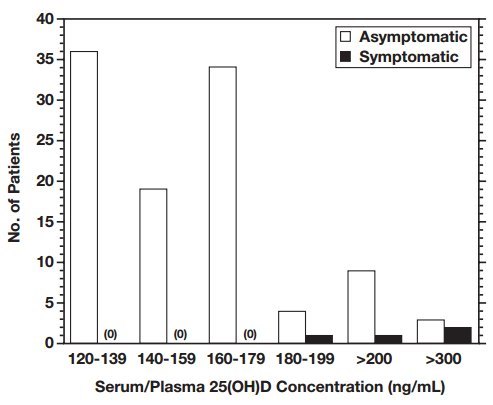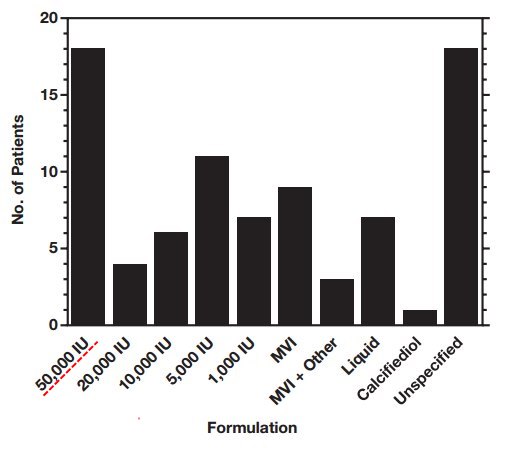Vitamin D toxicity is extremely rare, none if less than 180 ng
Vitamin D Toxicity: A 16-Year Retrospective Study at an Academic Medical Center.
Lab Med. 2018 Mar 21;49(2):123-129. doi: 10.1093/labmed/lmx077.
Lee JP1, Tansey M2, Jetton JG3, Krasowski MD1.
1 Department of Pathology, University of Iowa Hospitals and Clinics, Iowa City, IA.
2 Divisions of Pediatric Endocrinology, University of Iowa Stead Family Children's Hospital, Iowa City, IA.
3 Divisions of Pediatric Nephrology, Dialysis, and Transplantation, University of Iowa Stead Family Children's Hospital, Iowa City, IA.
No toxicity reported for <180 ng

50,000 IU was the most popular dose size


📄 Download the PDF from VitaminDWiki
BACKGROUND:
Interest in vitamin D has increased during the past 2 decades, with a corresponding increase in laboratory testing of 25-hydroxyvitamin D [25(OH)D]. The vast majority of specimens tested display normal or deficient levels of 25(OH)D; concentrations rarely fall in the potentially toxic range.
METHODS:
We performed a retrospective investigation of elevated 25(OH)D levels during a 16-year period at the University of Iowa Hospitals and Clinics (UIHC), a 734-bed tertiary-/quaternary-care academic medical center in the midwestern United States. Detailed medical-record review was performed for patients with serum/plasma 25(OH)D concentrations higher than 120 ng per mL.
RESULTS:
A total of 127,932 serum/plasma 25(OH)D measurements were performed on 73,779 unique patients. Of these patients, 780 (1.05%) had results that exceeded 80 ng per mL and 89 patients (0.12%) had results that exceeded 120 ng per mL. Only 4 patients showed symptoms of vitamin D toxicity. Three of these cases involved inadvertent misdosing of liquid formulations.
CONCLUSIONS:
Symptomatic vitamin D toxicity is uncommon, and elevated levels of 25(OH)D do not strongly correlate with clinical symptoms or total serum/plasma calcium levels. Our study highlights the potential risks of the liquid formulation of vitamin D.
